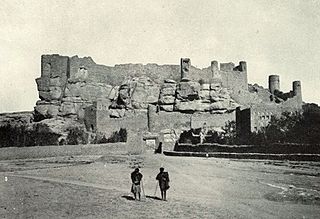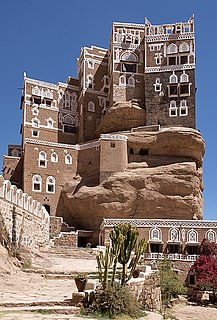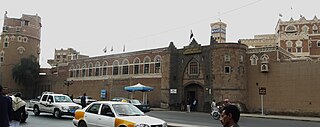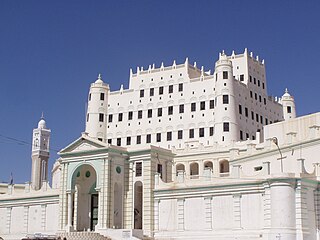 W
WAl-Qahira Castle is a historical castle in the ancient city of Taiz, Yemen. It is located on the northern slope of Mount Sabr, which is based on rocky highlands overlooking the city. It is said that the area was originally referred as the old Taiz, and later renamed as Al-Qahira (Cairo). The castle is considered as the nucleus of the city of Taiz.
 W
WThe Citadel of Rada'a is a historic castle in Yemen, located in the center of Rada'a District. The citadel sits at the highest point of the district, and consisted the original part of the city of Rada'a. The construction of the citadel precedes the introduction of Islam and dates back to the year 243 during the reign of Shammar Yahri'sh, the Himyarite king. Specifically, the upper part of the citadel dates back to the Hymyarite era. Later the citadel was restored and renovated during the time of Omar bin Abdulwahhab of the Tahirids dynasty. During this time, the other parts of the citadel were added, and the construction was ended during the time of Imam Yahya Hamid al-Din, who used the castle as a prison for the rebels. Its status as a prison lasted until the 1990s.
 W
WThe Dar al-Hajar is a former royal palace located in Wadi Dhar about 15 kilometres (9.3 mi) from Sana‘a, Yemen. Built in the 1920s as the summer retreat of Yahya Muhammad Hamid ed-Din, ruler of Yemen from 1904 to 1948, it sits on top of a structure built in 1786 for the scholar al-Imam Mansour. The palace stayed in the royal family until the Yemen revolution of 1962. The palace is now a museum. In 1974, Pier Paolo Pasolini used the palace as the home of Princess Dunya in his film The Arabian Nights.
 W
WDar al-Shukr is a royal palace located in Sana'a, Yemen. It is located near Qubbat al-Mutawakkil Mosque dome in Tahrir Square in the city centre.
 W
WDar as-Sa'd, also written Dar Al-Sada , is a royal palace located in Sana'a, Yemen. It is located near Qubbat al-Mutawakkil Mosque dome in Tahrir Square in the city centre.
 W
WThe Imams of Yemen and later the Kings of Yemen were religiously consecrated leaders belonging to the Zaidiyyah branch of Shia Islam. They established a blend of religious and secular rule in parts of Yemen from 897. Their imamate endured under varying circumstances until the republican revolution in 1962. Zaidiyyah theology differed from Isma'ili or Twelver Shi'ites by stressing the presence of an active and visible imam as leader. The imam was expected to be knowledgeable in religious scholarship, and to prove himself a worthy headman of the community, even in battle if this was necessary. A claimant of the imamate would proclaim a "call" (da'wa), and there were not infrequently more than one claimant.
 W
WSeiyun Palace was the royal residence of the sultan of Kathiri, located in the town of Seiyun in the Hadhramaut region, Yemen. It is one of the world’s largest mud-brick structures.
 W
WThe Mutawakkilite Kingdom of Yemen, also known as the Kingdom of Yemen or, retrospectively, as North Yemen, was a state that existed between 1918 and 1962 in the northern part of what is now Yemen. Its capital was Sana'a until 1948, then Taiz. From 1962 to 1970, it maintained control over portions of Yemen until its final defeat in the North Yemen Civil War. Yemen was admitted to the United Nations on 30 September 1947.